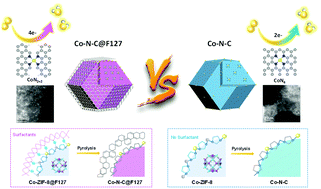当前位置:
X-MOL 学术
›
Energy Environ. Sci.
›
论文详情
Our official English website, www.x-mol.net, welcomes your
feedback! (Note: you will need to create a separate account there.)
Highly active atomically dispersed CoN4 fuel cell cathode catalysts derived from surfactant-assisted MOFs: carbon-shell confinement strategy†
Energy & Environmental Science ( IF 32.4 ) Pub Date : 2018-10-23 00:00:00 , DOI: 10.1039/c8ee02694g Yanghua He 1, 2, 3, 4, 5 , Sooyeon Hwang 5, 6, 7, 8 , David A. Cullen 5, 9, 10, 11 , M. Aman Uddin 5, 12, 13, 14 , Lisa Langhorst 5, 12, 13, 14 , Boyang Li 5, 14, 15, 16 , Stavros Karakalos 5, 17, 18, 19 , A. Jeremy Kropf 5, 20, 21, 22 , Evan C. Wegener 5, 20, 21, 22 , Joshua Sokolowski 1, 2, 3, 4, 5 , Mengjie Chen 1, 2, 3, 4, 5 , Debbie Myers 5, 20, 21, 22 , Dong Su 5, 9, 10, 11 , Karren L. More 5, 10, 11, 23 , Guofeng Wang 5, 14, 15, 16 , Shawn Litster 5, 12, 13, 14 , Gang Wu 1, 2, 3, 4, 5
Energy & Environmental Science ( IF 32.4 ) Pub Date : 2018-10-23 00:00:00 , DOI: 10.1039/c8ee02694g Yanghua He 1, 2, 3, 4, 5 , Sooyeon Hwang 5, 6, 7, 8 , David A. Cullen 5, 9, 10, 11 , M. Aman Uddin 5, 12, 13, 14 , Lisa Langhorst 5, 12, 13, 14 , Boyang Li 5, 14, 15, 16 , Stavros Karakalos 5, 17, 18, 19 , A. Jeremy Kropf 5, 20, 21, 22 , Evan C. Wegener 5, 20, 21, 22 , Joshua Sokolowski 1, 2, 3, 4, 5 , Mengjie Chen 1, 2, 3, 4, 5 , Debbie Myers 5, 20, 21, 22 , Dong Su 5, 9, 10, 11 , Karren L. More 5, 10, 11, 23 , Guofeng Wang 5, 14, 15, 16 , Shawn Litster 5, 12, 13, 14 , Gang Wu 1, 2, 3, 4, 5
Affiliation

|
Development of platinum group metal (PGM)-free catalysts for oxygen reduction reaction (ORR) is essential for affordable proton exchange membrane fuel cells. Herein, a new type of atomically dispersed Co doped carbon catalyst with a core–shell structure has been developed via a surfactant-assisted metal–organic framework approach. The cohesive interactions between the selected surfactant and the Co-doped zeolitic imidazolate framework (ZIF-8) nanocrystals lead to a unique confinement effect. During the thermal activation, this confinement effect suppressed the agglomeration of Co atomic sites and mitigated the collapse of internal microporous structures of ZIF-8. Among the studied surfactants, Pluronic F127 block copolymer led to the greatest performance gains with a doubling of the active site density relative to that of the surfactant-free catalyst. According to density functional theory calculations, unlike other Co catalysts, this new atomically dispersed Co–N–C@F127 catalyst is believed to contain substantial CoN2+2 sites, which are active and thermodynamically favorable for the four-electron ORR pathway. The Co–N–C@F127 catalyst exhibits an unprecedented ORR activity with a half-wave potential (E1/2) of 0.84 V (vs. RHE) as well as enhanced stability in the corrosive acidic media. It also demonstrated high initial performance with a power density of 0.87 W cm−2 along with encouraging durability in H2–O2 fuel cells. The atomically dispersed Co site catalyst approaches that of the Fe–N–C catalyst and represents the highest reported PGM-free and Fe-free catalyst performance.
中文翻译:

由表面活性剂辅助的MOF衍生的 高活性原子分散的CoN 4燃料电池阴极催化剂:碳壳限制策略†
对于可负担得起的质子交换膜燃料电池,开发用于氧还原反应(ORR)的不含铂族金属(PGM)的催化剂至关重要。在这里,已经开发了一种新型的具有核-壳结构的原子分散的掺Co碳催化剂。表面活性剂辅助的金属有机框架方法。所选表面活性剂和共掺杂的沸石咪唑酸酯骨架(ZIF-8)纳米晶体之间的内聚相互作用导致独特的封闭效应。在热活化过程中,这种限制作用抑制了Co原子位的团聚并减轻了ZIF-8内部微孔结构的塌陷。在所研究的表面活性剂中,相对于不含表面活性剂的催化剂,Pluronic F127嵌段共聚物可实现最大的性能提升,且活性位点密度增加一倍。根据密度泛函理论计算,与其他Co催化剂不同,这种新型原子分散的Co–N–C @ F127催化剂被认为含有大量的CoN 2 + 2这些位点对于四电子ORR途径是活跃的,并且在热力学上是有利的。Co–N–C @ F127催化剂具有空前的ORR活性,半波电势(E 1/2)为0.84 V(相对于RHE),并在腐蚀性酸性介质中具有更高的稳定性。它还显示出高初始性能,功率密度为0.87 W cm -2,并且在H 2 -O 2燃料电池中具有令人鼓舞的耐用性。原子分散的Co中心催化剂接近Fe–N–C催化剂,代表了报道的最高无PGM和无Fe催化剂性能。
更新日期:2018-10-23
中文翻译:

由表面活性剂辅助的MOF衍生的 高活性原子分散的CoN 4燃料电池阴极催化剂:碳壳限制策略†
对于可负担得起的质子交换膜燃料电池,开发用于氧还原反应(ORR)的不含铂族金属(PGM)的催化剂至关重要。在这里,已经开发了一种新型的具有核-壳结构的原子分散的掺Co碳催化剂。表面活性剂辅助的金属有机框架方法。所选表面活性剂和共掺杂的沸石咪唑酸酯骨架(ZIF-8)纳米晶体之间的内聚相互作用导致独特的封闭效应。在热活化过程中,这种限制作用抑制了Co原子位的团聚并减轻了ZIF-8内部微孔结构的塌陷。在所研究的表面活性剂中,相对于不含表面活性剂的催化剂,Pluronic F127嵌段共聚物可实现最大的性能提升,且活性位点密度增加一倍。根据密度泛函理论计算,与其他Co催化剂不同,这种新型原子分散的Co–N–C @ F127催化剂被认为含有大量的CoN 2 + 2这些位点对于四电子ORR途径是活跃的,并且在热力学上是有利的。Co–N–C @ F127催化剂具有空前的ORR活性,半波电势(E 1/2)为0.84 V(相对于RHE),并在腐蚀性酸性介质中具有更高的稳定性。它还显示出高初始性能,功率密度为0.87 W cm -2,并且在H 2 -O 2燃料电池中具有令人鼓舞的耐用性。原子分散的Co中心催化剂接近Fe–N–C催化剂,代表了报道的最高无PGM和无Fe催化剂性能。











































 京公网安备 11010802027423号
京公网安备 11010802027423号